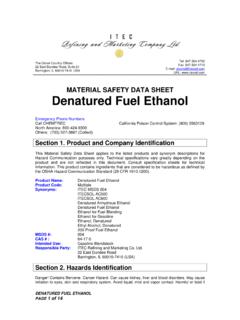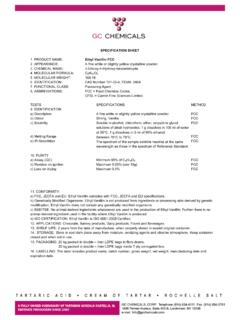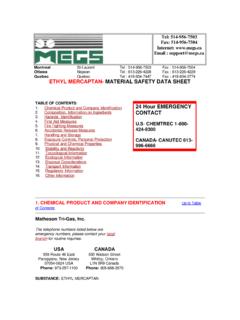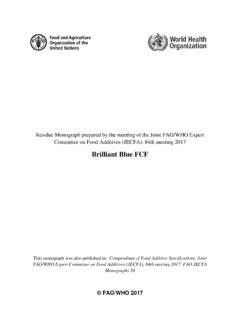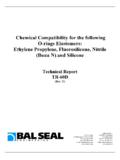Transcription of Ethyl Alcohol - ITEC Ref
1 Ethyl Alcohol handbook A Lyondell Company Ethyl Alcohol handbook 6TH EDITION. Pure Ethyl Alcohol Specially Denatured Alcohol Alcohol Solvents Completely Denatured Alcohol THE INFORMATION IN THIS BOOKLET IS, TO OUR BEST KNOWLEDGE, TRUE AND ACCURATE. HOWEVER, SINCE CONDITIONS OF USE ARE BEYOND OUR CONTROL, ALL RECOMMENDATIONS. OR SUGGESTIONS ARE PRESENTED WITHOUT GUARANTEE OR RESPONSIBILITY ON OUR PART. WE DISLCAIM ALL LIABILITY IN CONNECTION WITH THE USE OF INFORMATION CONTAINED. HEREIN OR OTHERWISE. ALL RISKS OF SUCH USE ARE ASSUMED BY THE USER. FURTHERMORE, NOTHING CONTAINED HEREIN SHALL BE CONSTRUCTED AS AN INDUCEMENT. OR RECOMMENDATION TO USE ANY PROCESS OR TO MANUFACTURE OR USE ANY PRODUCT IN. CONFLICT WITH EXISTING OR FUTURE PATENTS. COPYRIGHT EQUISTAR CHEMICALS, LP 2003 2. This handbook presents a comprehensive review of the history, authorized uses, specifications, test methods, physical properties, and storage of industrial Ethyl Alcohol .
2 Government regulations governing the acquisition and use of industrial Alcohol are subject to change and are, therefore, presented as a separate booklet, "Government Regulations," which is available from Equistar Chemicals, LP. This booklet is revised and reprinted by Equistar as regulatory changes make it necessary. TABLE OF CONTENTS Introduction .. 6. Punctilious Ethyl Alcohol .. 14. Pure Ethyl Alcohol .. 18. Specially Denatured Alcohol .. 22. Alcohol Solvents .. 45. Proprietary Solvents .. 46. Filmex Industrial Solvents .. 51. Completely Denatured Alcohol .. 54. Ethyl Alcohol Properties .. 58. Analytical Test Methods .. 79. Storage and Maintenance of Quality .. 86. Health and Safety Information .. 98. Bibliography .. 105. Glossary of Terms .. 108. 4. Equistar Chemicals, LP, headquartered in Houston, Texas, is a joint venture between Lyondell Chemical Company ( interest) and Millennium Chemicals Inc.
3 ( interest) and combines their olefins, polymers and oxygenated chemicals businesses. Equistar is one of the world's largest producers of ethylene, propylene and polyethylene and a leading producer of ethylene oxide, ethylene glycol, specialty polymers, wire and cable resins, and polyolefin powders. Equistar was formed in December 1997 and has 16. manufacturing sites located primarily along the Gulf Coast and in the Midwest. Lyondell Chemical Company, headquartered in Houston, is a leading producer of propylene oxide (PO), toluene diisocyanate (TDI), propylene glycol (PG), butanediol (BDO) and propylene glycol ether (PGE); styrene monomer and MTBE. Through its interest in LYONDELL-CITGO Refining LP, Lyondell is one of the largest refiners in the United States, principally processing extra heavy Venezuelan crude oil to produce gasoline, low sulfur diesel and jet fuel. 5. INTRODUCTION Alcohol : Myths and Realities.
4 7. The Law and Ethyl Alcohol .. 8. Equistar Chemicals, LP and Industrial Ethyl Alcohol .. 9. Services of Equistar Chemicals, LP .. 9. What Is Ethyl Alcohol .. 10. The Sources of Industrial Ethyl Alcohol .. 10. Fermentation of Agricultural Products .. 10. Synthesis From Natural Gas .. 10. The Equistar Chemicals, LP Direct Hydration Process .. 11. Anhydrous Alcohol by Molecular Sieve Distillation .. 11. Flow Chart: Synthesis of Ethyl Alcohol from Ethylene .. 12. Punctilious Ethyl Alcohol .. 14. Industrial Alcohol Available From Equistar Chemicals, LP .. 14. Uses of Industrial Alcohol .. 15. Pure Ethyl Alcohol .. 15. Denatured Alcohol .. 15. Typical Industrial Alcohol Applications .. 15. 6. Alcohol : Myths and Realities Ethyl Alcohol has probably been used by human beings as a beverage for at least 300. centuries. Each culture has its own myths about the discovery and significance of this potent liquid.
5 Who discovered it, and how the discovery came about, are lost in antiquity as is the discovery of fire and the invention of the wheel. But, however, and by whom Alcohol came into existence, much has happened because of it. Some contend it started the first community life, since several years are required to produce a vineyard. Thus, the pursuit of the fermented product of the juice of grapes may have changed the nomadic pattern of early man to a settled one. The historical references to Alcohol do not appear until 60 or 70 centuries ago in the Hebrew script, on Babylonian tablets, and in ancient Egyptian carvings picturing the manufacture of wine by fermentation. Wine was believed to be made in China before 2000 The Bible holds wine in high esteem, suggesting that wine is a gift of God, referring to bread and wine as staples of the diet, and including wine as a measure of hospitality and of value as a medicine and an anesthetic.
6 FROM KUHL TO ALKOHOL. The generally accepted derivation of the word " Alcohol " is from the Arabic kuhl, or kohol meaning a very fine powder. Alkohol or "the fine powder" referred usually to a finely powdered antimony sulfide used in cosmetics to darken the eyelids. For example, ferrum alcoholisatum was finely powdered iron. Gradually the word came to mean "essence", and Paracelsus defined it in the 16th century as the most subtle part of anything. It was in this sense, he wrote of alcool vini', the most subtle part of wine, but never of alcool'. alone. It was not until the 19th century that the term Alcohol came to be used generally for wine spirits. Ethyl Alcohol . Probably because of its being the essence of wine and the intoxicating ingredient in many beverages whose production involved a fermentation process, Ethyl Alcohol must have been one of the earliest organic compounds to be investigated.
7 Despite the Arabic origin of the word Alcohol , the separation of Ethyl Alcohol from wine was apparently unknown to Arabian alchemists. The earliest known description of the concentration of Ethyl Alcohol by distillation of wine occurs in a Latin manuscript of the 12th century. It is assumed that Ethyl Alcohol was first separated by distillation around the 11th century in the wine districts of Italy. Although Ethyl Alcohol had been known for a considerable time in a crude state in wines and beer, it was not until 1796 that Johann Tobias Lowitz first prepared it free of water. Its composition was determined in 1808 by Th odore de Sassure although Lavoisier had established its qualitative formula even earlier. Its structural formula was established by Sir Edward Frankland later in the 19th century. In the naming of Ethyl Alcohol , the limiting term Ethyl refers to the fact that this particular Alcohol can be converted to ether.
8 The "yl" suffix is derived from the Greek word "hyle". and was employed first by Justus von Liebig and Frederick Wohler in the sense of "stuff". or "material" similar to Paracelsus' "essence.". Ethyl Alcohol TODAY. Ethyl Alcohol , one of the oldest organic chemicals known, is a vital industrial material from which other manufacturers make their finished products. 7. Completely aside from its use in beverages, which is usually our first point of reference when we think about Alcohol , Ethyl Alcohol is one of the most important chemicals available to industry and is involved in the manufacture of many of the significant products of the second half of the 20th century. Its solvent power is particularly useful for the extraction of medicinals from plant and animal tissues and for compounding tonics, syrups, tinctures, liniments and antiseptics. It is used in processing vaccines and is essential to the manufacture of pharmaceuticals such as antibiotics, and numerous over-the-counter preparations.
9 As an industrial raw material, Ethyl Alcohol is involved in the manufacture of adhesives, toiletries, detergents, explosives, inks, chemicals, hand creams, plastics, paints, thinners, textiles, vinegar and other products almost too numerous to mention. While Ethyl Alcohol has been around since antiquity, scientists today are still discovering new and important uses for it. Watch the contrail of a jet thread the sky with its wisp of white. Stroke the satin- smoothness of a graceful racing sloop. Fire a rifle. Paint a house. Buy a tire. Take a pill. Set your hair. Treat a cut. Eat a meal. Print a book. Ethyl Alcohol is involved. The Law and Ethyl Alcohol LIMITING EFFECTS OF TAXATION. While Ethyl Alcohol has always played a major role in productive communities, its use has been traditionally disciplined by custom and legislation. Until the pressing needs of industry precipitated changes in the law, the principle of taxing and regulating alcoholic beverages was applied to all forms of Ethyl Alcohol , regardless of its ultimate use.
10 In those countries where no special legislation had permitted the use of tax-free Alcohol for industrial purposes, a heavy burden of taxation was placed on every gallon of Ethyl Alcohol produced. For Alcohol , in the view of the law, was a beverage of luxury. Its consumption had, for centuries, provided a rich source of tax income. Until the middle of the 19th century, no government was willing to jeopardize this income by eliminating the tax on pure Alcohol which, although destined for industry, might have been diverted, tax- free, into alcoholic beverages. LIBERATING INFLUENCE OF THE INDUSTRIAL REVOLUTION. England, first to see the smoke and hear the hum of the Industrial Revolution, was also first to recognize the industrial significance of Ethyl Alcohol . Realizing that this vital commodity had to be made economically viable for use in its emerging industries, England, in 1855, authorized the use of tax-free Alcohol for manufacturing purposes.
